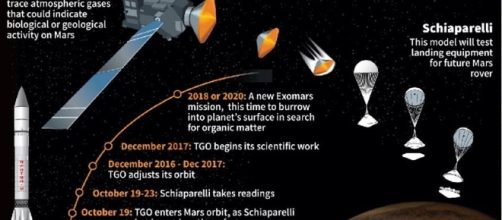On a joint cooperation, the European Space Agency (ESA) and Roscosmos State Corporation launched their first mission to Mars known as ExoMars 2016. The mission includes the Trace Gas Orbiter (TGO) and the Schiaparelli lander. The spacecraft was launched on a Proton rocket from Baikonur. This stablisehes the first mutual cooperation in the European Russian exploration of Mars. ExoMars 2016 is planned to arrive at Mars on October 2016.
Science objectives
The mission intends to search for evidences of past and present biological marks, atmospheric composition, the way in which water and the geochemistry in Mars varies.
It also intends to identify the surface environment and detect possible dangers for future missions. Study the subsurface and deep interior of the planet and return a sample from the red planet´s surface to earth.
Technical objectives
This mission will permit both Russia and the ESA to confirm the advanced technologies used for the entry into Mars´ gravitational field, the descent through its atmosphere and the landing on its surface. The ability to communicate and control a rover by utilizing solar power and further engineering implementations for future solar system explorations.
Spacecraft and instruments
For the study of Mars´ atmosphere and geology, the mission comprises two vehicles; the ExoMars Trace Gas Orbiter (TGO) and the stationary lander known as Schiaparelli.
TGO will search for methane contents within Mars‘ atmosphere and traces of other gases. Schiaparelli is equipped with sensors that will assess the performance of the lander during descending and to study the environment around.
ExoMars is a program at ESA consisting of two missions. The first mission was launched on 14 March 2016 and will arrive at Mars on October 2016. The second mission is planned to be launched in July 2020 and will send a rover to Mars. In total, the ExoMars mission will send four spacecraft to Mars; one orbiter, one rover and two stationary landers.
Oxia Planum has been selected as a suitable site for this mission´s Mars´ exploration. It´s believed to be potentially viable due to its smooth surface and bio signatures.

